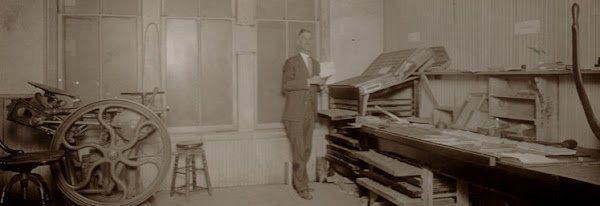A week ago last Sunday I printed my first real project. It was for a letterpress swap and only ran to about 75 sheets but was the first thing I’ve printed in “bulk” for distribution. Everything came out reasonably well and I was very happy with the way the press worked. During this process I learned, or perhaps was reminded of something, I thought I’d share here.
I made a previous post describing how I adjusted the platen on my press at the time I restored it. I adjusted it at all four corners using a machinist’s gauge and I spent considerable time loosing and tightening the platen bolts until everything was set to the gauge. And in fact when I printed a small business card form, it was just fine.
When dressing the platen and before inking the press my practice has been to use a sheet of the old-style dark blue/purple “carbon” paper with a test sheet to pull a proof, turning the flywheel over by hand while holding the two sheets between the platen and the form. Once I’m sure everything is where it should be I ink the press and pull an impression on the tympan that I then use to set the gauge pins following the usual procedure.
The form for my project had a printed area of about 4” x 6”. I had locked it up in the chase slightly below the centerline as is normally recommended. When I pulled the proof using the carbon the impression, while generally even, was lighter at the top than the bottom. For a second I was surprised considering the care I had used setting the platen. But then I realized that an actual form introduces a variable and especially the size of the form.
The answer was to adjust the top two platen bolts very, very slightly to move the top of the platen towards the bed. I then took a trial impression and made another very small adjustment until the impression was truly equal. In fact, the impression was so good that I didn’t feel I needed makeready and so proceeded with the run. Looking back I think there were one or two things I would have spotted-up but in general I was satisfied with the impression. I saved my proofs and will scan them and a copy of the final print and post them tomorrow when I have more time.
So while gauges provide a useful starting point the proof, as always, is in the printing.
Followup: Just to be clear, once I get the platen properly set, and I'm hoping that has now been achieved, I don't expect to have to adjust it again except in extraordinary circumstances. But having recently disassembled, cleaned, reassembled and initially adjusted everything, I'm not surprised it required a bit more tweeking.
The usual means of adjusting the platen is to lock up either four large sorts, one in each corner, or a foundry type border all around the edge of the chase. Then test proofs are taken on the tympan and adjustments made accordingly. I have nothing against that method but when I tried it on my old 8x12 I personally didn't have much success. When I made the adjustment with the method I've also now used on my 10x15 things worked out very well.
Subscribe to:
Post Comments (Atom)



2 comments:
This is definitely a useful thing to keep in mind - always adjusting, right? It sounds like your first big project went great; can't wait to see pictures.
I wish I had signed up for this swap - it's going to be so nice to receive everyone's work.
Why do you use carbon paper?
-Maggie
I use carbon paper to get a proof without having to ink the press. It's not essential by any means but it's a quick, easy check of the form and packing.
Once I get the platen properly set, and I'm hoping that has now been achieved, I don't expect to have to do it again. But having recently disassembled, cleaned, reassembled and initially adjusted everything, I'm not surprised it required a bit more tweeking.
The usual means of adjusting the platen is to lock up either four large sorts, one in each corner, or a foundry type border all around the edge of the chase. Then test proofs are taken on the tympan and adjustments made accordingly. I have nothing against that method but when I tried it on my old 8x12 I personally didn't have much success. When I made the adjustment with the method I've also now used on my 10x15 things worked out very well.
Post a Comment